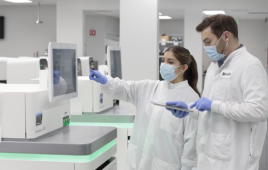DNA, it has turned out, isn’t all it was cracked up to be. In recent years we learned that the molecule of life, the discovery of the 20th century, did not — could not — by itself explain the huge differences in complexity between a human and a worm. Forced to look elsewhere, scientists turned to RNA, a direct, yet, more complex transcript of DNA. But methodological problems have historically plagued the study of RNA regulation in living cells, limiting not only the accuracy of results but also our understanding of RNA’s role in human disease.
But now, in research to appear in the November 2 advance online issue of Nature, Robert B. Darnell, head of the Laboratory of Molecular Neuro-oncology at Rockefeller University and a Howard Hughes Medical Institute investigator, and his team have changed all that.
By adapting techniques mastered in the test tube and combining them with high throughput technology, the team has developed a genome-wide platform to study how specialized proteins regulate RNA in living, intact cells. The platform allows researchers to identify, in a single experiment, every sequence within every strand of RNA to which proteins bind. The result is an unbiased and unprecedented look at how differences in RNA can explain how a worm and a human can each have 25,000 genes yet be so different.
‘RNA offers a way to make the cell much more complex than what this limited set of genes can offer,’ says Darnell, who is Robert and Harriet Heilbrunn Professor at Rockefeller. ‘But how is RNA being regulated in different conditions and diseases, and in different cell types? With this platform, we now have a way to address all these questions.’
Traditional methods used molecules to extract protein-RNA complexes from living tissue. But often the molecule only extracted the RNA. Other times, the protein bound too weakly to survive the purification process, which involved stripping the complex of unwanted debris. To address the issue, Darnell and his team used a trick from test-tube biochemistry that molecularly cements these regulatory proteins to RNA at the moment they touch. The technique, when applied to high throughput sequencing, is called high throughput sequencing–cross linking immunoprecipitation, or HITS-CLIP for short.
Since the RNA and RNA-binding protein are fused together, the researchers can really beat up the extract and rigorously purify the protein without fear of losing the RNA. At the end of the day, they are left with the RNA sequence to which the protein was bound. They can then take these sequences to Rockefeller’s high throughput sequence facility, and with the help of Research Support Specialist Scott Dewell, overlay them onto the genome and see where they match. What they get is a map of every position on every transcribed RNA where the RNA binding protein is binding.
When DNA is transcribed into RNA, the primary transcript is divided into many blocks called exons, which are separated by empty spaces. In order to convert the transcript into some sort of message, all the spaces need to be removed, but if an exon is dropped, a different version of that protein, which could carry a very different message, is created. ‘That’s RNA splicing,’ says first author Donny Licatalosi, a postdoctoral associate in the lab. ‘It is what gives rise to this massive pool of diverse and complex tissues with a relatively small number of genes.’
In the past, the group used a sophisticated process of evidence and inference to make predictions of the points of regulation along the transcript. ‘Now, we have direct biochemical validation that these interactions occur in the brain to regulate splicing,’ says Licatalosi. And as it turns out, ‘The observed map — and this was amazing — looked just like our predicted map,’ says Darnell.
Darnell, Licatalosi and their colleagues Aldo Mele, a research assistant, John Fak, a research assistant, Sung-Wook Chi, a graduate fellow in computational biology and medicine, Xuning Wang, assistant director of biocomputing, and Jennifer Darnell, a research associate professor, looked at an RNA-binding protein called Nova2 that is found exclusively in neurons. They found that depending on where Nova2 binds to RNA, they could predict and directly observe whether an exon would be included or excluded in the final transcript, and which protein version it created. ‘The cell seems to be going through great trouble to regulate these RNAs in different conditions and different cell types,’ says Darnell. ‘When RNA developed the ability to make a more stable copy of itself — DNA — it didn’t write itself off as a relic for the textbooks. It stayed at the core of complex processes in the cell.’
Release Date: November 3, 2008
Source: Rockefeller University
Filed Under: Genomics/Proteomics




